Quality Improvement Plan Template for Meeting National Quality Standard
VerifiedAdded on 2023/06/11
|27
|3046
|485
AI Summary
This Quality Improvement Plan template helps in meeting the National Quality Standard for educational programs and practices, children's health and safety, physical environment, staffing arrangements, relationships with children, and collaborative partnerships with families and communities.
Contribute Materials
Your contribution can guide someone’s learning journey. Share your
documents today.
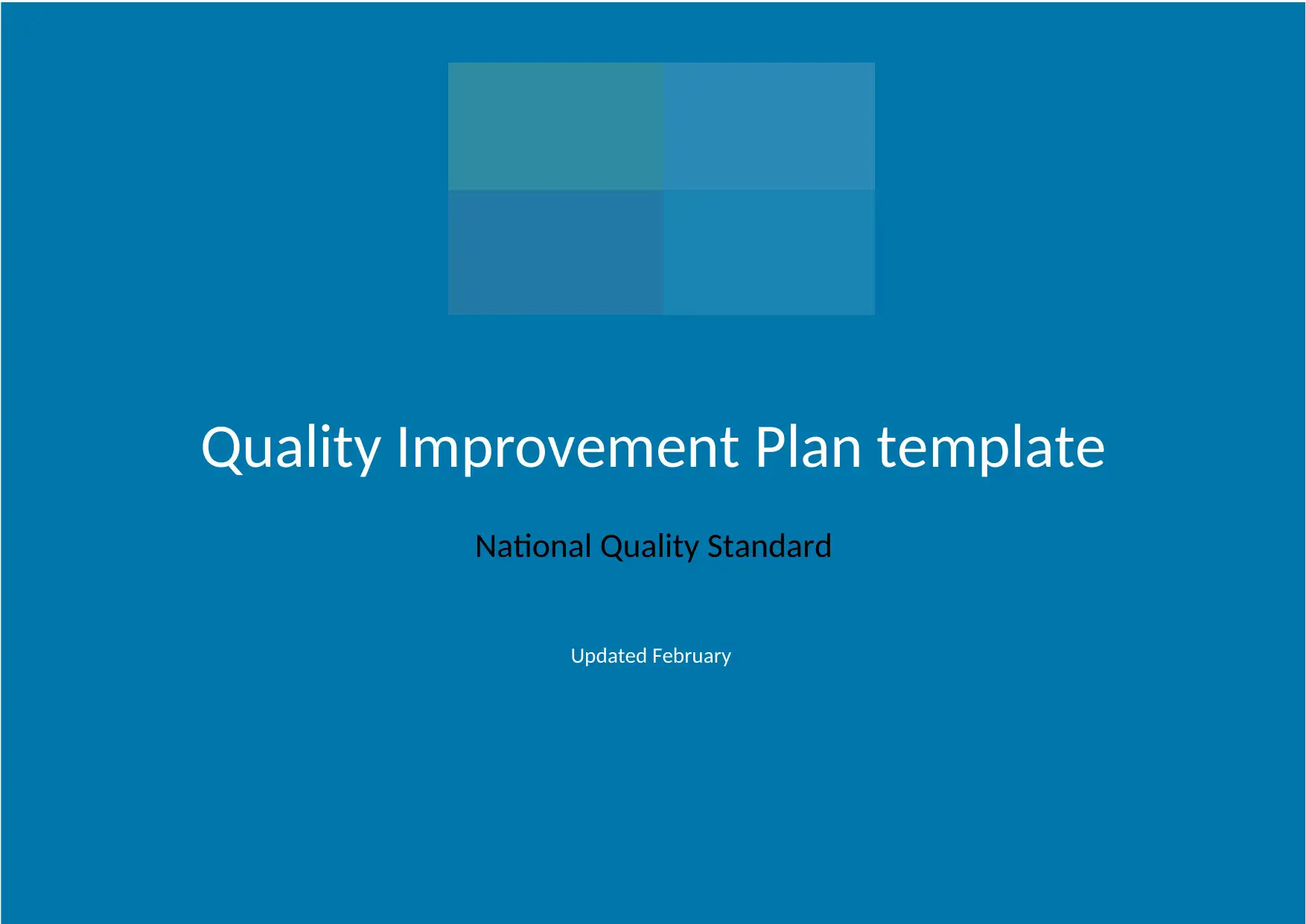
Quality Improvement Plan template 2
Quality Improvement Plan template
National Quality Standard
Updated February
Quality Improvement Plan template
National Quality Standard
Updated February
Secure Best Marks with AI Grader
Need help grading? Try our AI Grader for instant feedback on your assignments.

Service details For confidentiality reasons, please do not use the real details of people or the service. You can make up your own details in this space.
Service name : Meeting National Quality Standard for a standard Service approval number
Primary contacts at service
Physical location of service Physical location contact details
Street Telephone
Suburb Mobile
State/territory Fax
Postcode Email
Approved Provider Nominated Supervisor
Primary contact Name
Telephone Telephone
Mobile Mobile
Fax Fax
Email Email
Educational leader
Name
Telephone
Email
Quality Improvement Plan template 3
Service name : Meeting National Quality Standard for a standard Service approval number
Primary contacts at service
Physical location of service Physical location contact details
Street Telephone
Suburb Mobile
State/territory Fax
Postcode Email
Approved Provider Nominated Supervisor
Primary contact Name
Telephone Telephone
Mobile Mobile
Fax Fax
Email Email
Educational leader
Name
Telephone
Quality Improvement Plan template 3
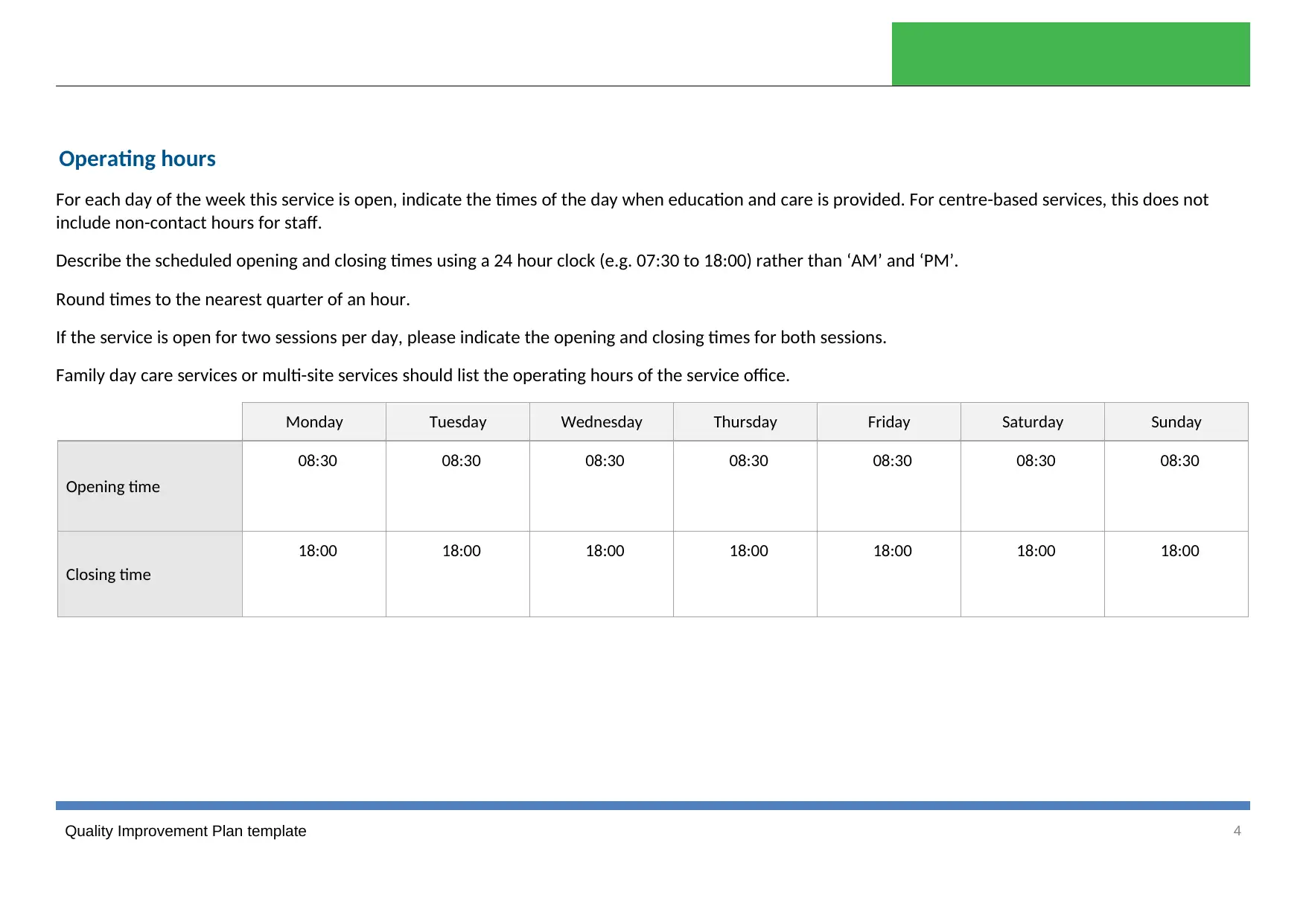
Operating hours
For each day of the week this service is open, indicate the times of the day when education and care is provided. For centre-based services, this does not
include non-contact hours for staff.
Describe the scheduled opening and closing times using a 24 hour clock (e.g. 07:30 to 18:00) rather than ‘AM’ and ‘PM’.
Round times to the nearest quarter of an hour.
If the service is open for two sessions per day, please indicate the opening and closing times for both sessions.
Family day care services or multi-site services should list the operating hours of the service office.
Monday Tuesday Wednesday Thursday Friday Saturday Sunday
Opening time
08:30 08:30 08:30 08:30 08:30 08:30 08:30
Closing time
18:00 18:00 18:00 18:00 18:00 18:00 18:00
Quality Improvement Plan template 4
For each day of the week this service is open, indicate the times of the day when education and care is provided. For centre-based services, this does not
include non-contact hours for staff.
Describe the scheduled opening and closing times using a 24 hour clock (e.g. 07:30 to 18:00) rather than ‘AM’ and ‘PM’.
Round times to the nearest quarter of an hour.
If the service is open for two sessions per day, please indicate the opening and closing times for both sessions.
Family day care services or multi-site services should list the operating hours of the service office.
Monday Tuesday Wednesday Thursday Friday Saturday Sunday
Opening time
08:30 08:30 08:30 08:30 08:30 08:30 08:30
Closing time
18:00 18:00 18:00 18:00 18:00 18:00 18:00
Quality Improvement Plan template 4
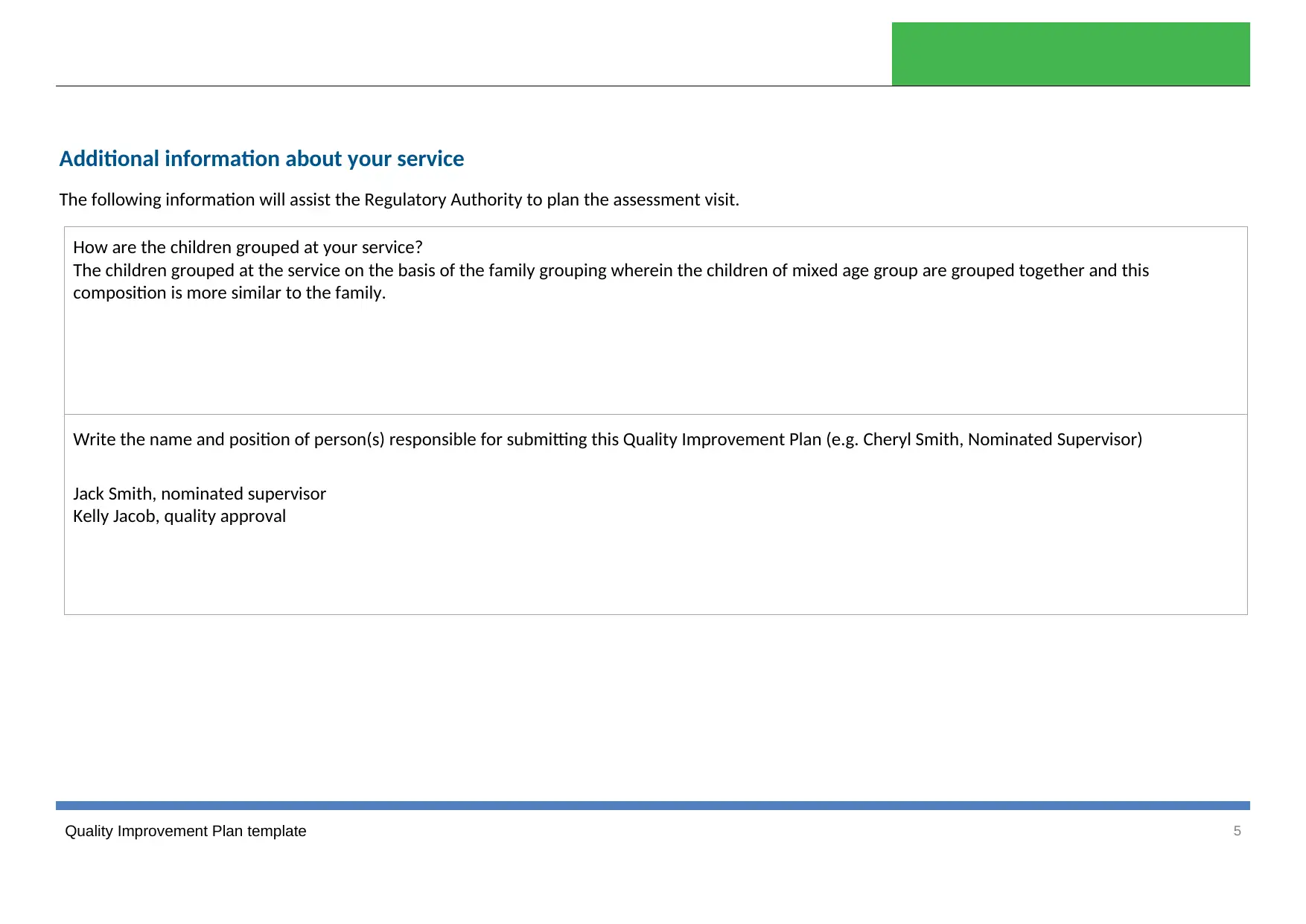
Additional information about your service
The following information will assist the Regulatory Authority to plan the assessment visit.
How are the children grouped at your service?
The children grouped at the service on the basis of the family grouping wherein the children of mixed age group are grouped together and this
composition is more similar to the family.
Write the name and position of person(s) responsible for submitting this Quality Improvement Plan (e.g. Cheryl Smith, Nominated Supervisor)
Jack Smith, nominated supervisor
Kelly Jacob, quality approval
Quality Improvement Plan template 5
The following information will assist the Regulatory Authority to plan the assessment visit.
How are the children grouped at your service?
The children grouped at the service on the basis of the family grouping wherein the children of mixed age group are grouped together and this
composition is more similar to the family.
Write the name and position of person(s) responsible for submitting this Quality Improvement Plan (e.g. Cheryl Smith, Nominated Supervisor)
Jack Smith, nominated supervisor
Kelly Jacob, quality approval
Quality Improvement Plan template 5
Secure Best Marks with AI Grader
Need help grading? Try our AI Grader for instant feedback on your assignments.
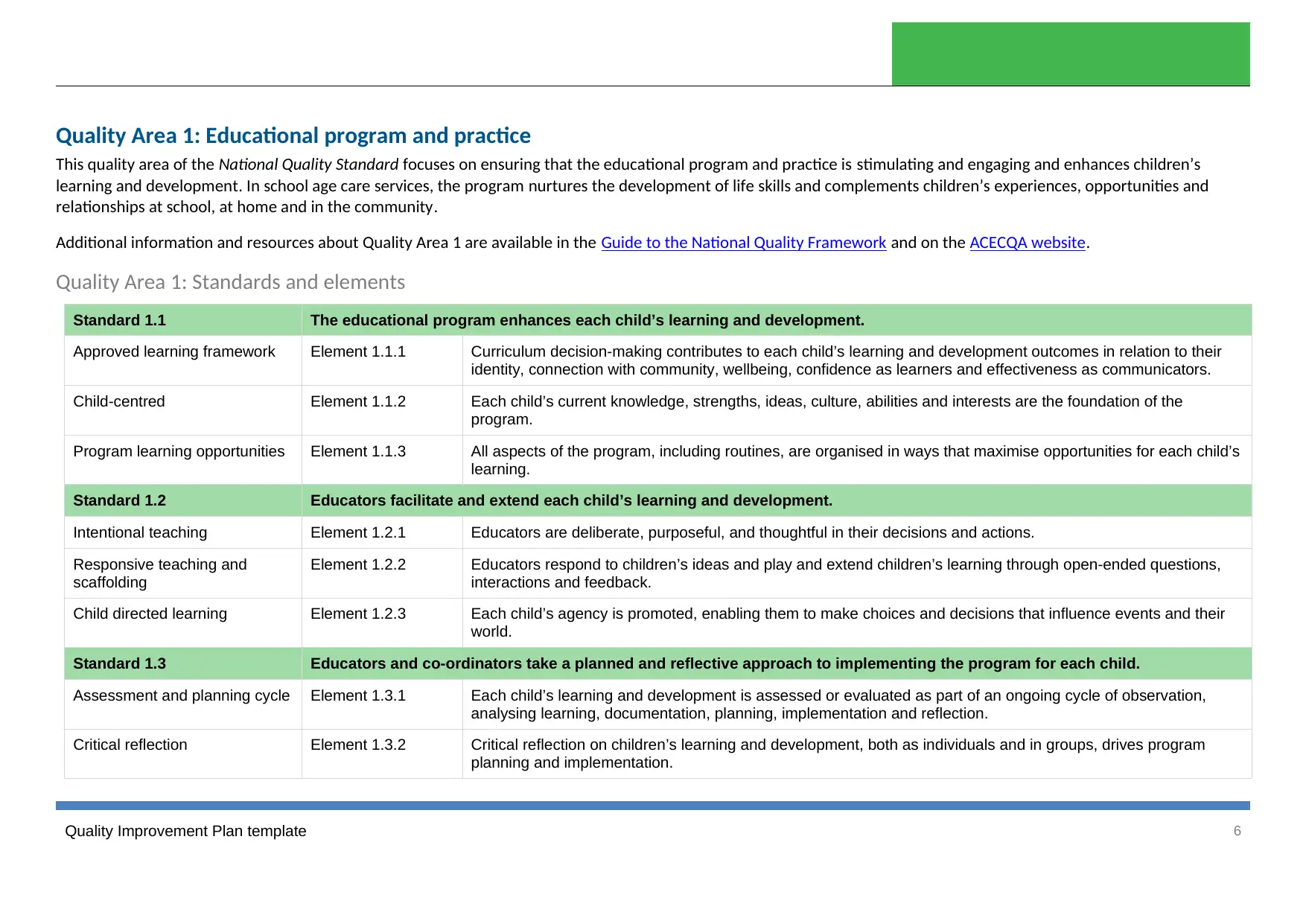
Quality Area 1: Educational program and practice
This quality area of the National Quality Standard focuses on ensuring that the educational program and practice is stimulating and engaging and enhances children’s
learning and development. In school age care services, the program nurtures the development of life skills and complements children’s experiences, opportunities and
relationships at school, at home and in the community.
Additional information and resources about Quality Area 1 are available in the Guide to the National Quality Framework and on the ACECQA website.
Quality Area 1: Standards and elements
Standard 1.1 The educational program enhances each child’s learning and development.
Approved learning framework Element 1.1.1 Curriculum decision-making contributes to each child’s learning and development outcomes in relation to their
identity, connection with community, wellbeing, confidence as learners and effectiveness as communicators.
Child-centred Element 1.1.2 Each child’s current knowledge, strengths, ideas, culture, abilities and interests are the foundation of the
program.
Program learning opportunities Element 1.1.3 All aspects of the program, including routines, are organised in ways that maximise opportunities for each child’s
learning.
Standard 1.2 Educators facilitate and extend each child’s learning and development.
Intentional teaching Element 1.2.1 Educators are deliberate, purposeful, and thoughtful in their decisions and actions.
Responsive teaching and
scaffolding
Element 1.2.2 Educators respond to children’s ideas and play and extend children’s learning through open-ended questions,
interactions and feedback.
Child directed learning Element 1.2.3 Each child’s agency is promoted, enabling them to make choices and decisions that influence events and their
world.
Standard 1.3 Educators and co-ordinators take a planned and reflective approach to implementing the program for each child.
Assessment and planning cycle Element 1.3.1 Each child’s learning and development is assessed or evaluated as part of an ongoing cycle of observation,
analysing learning, documentation, planning, implementation and reflection.
Critical reflection Element 1.3.2 Critical reflection on children’s learning and development, both as individuals and in groups, drives program
planning and implementation.
Quality Improvement Plan template 6
This quality area of the National Quality Standard focuses on ensuring that the educational program and practice is stimulating and engaging and enhances children’s
learning and development. In school age care services, the program nurtures the development of life skills and complements children’s experiences, opportunities and
relationships at school, at home and in the community.
Additional information and resources about Quality Area 1 are available in the Guide to the National Quality Framework and on the ACECQA website.
Quality Area 1: Standards and elements
Standard 1.1 The educational program enhances each child’s learning and development.
Approved learning framework Element 1.1.1 Curriculum decision-making contributes to each child’s learning and development outcomes in relation to their
identity, connection with community, wellbeing, confidence as learners and effectiveness as communicators.
Child-centred Element 1.1.2 Each child’s current knowledge, strengths, ideas, culture, abilities and interests are the foundation of the
program.
Program learning opportunities Element 1.1.3 All aspects of the program, including routines, are organised in ways that maximise opportunities for each child’s
learning.
Standard 1.2 Educators facilitate and extend each child’s learning and development.
Intentional teaching Element 1.2.1 Educators are deliberate, purposeful, and thoughtful in their decisions and actions.
Responsive teaching and
scaffolding
Element 1.2.2 Educators respond to children’s ideas and play and extend children’s learning through open-ended questions,
interactions and feedback.
Child directed learning Element 1.2.3 Each child’s agency is promoted, enabling them to make choices and decisions that influence events and their
world.
Standard 1.3 Educators and co-ordinators take a planned and reflective approach to implementing the program for each child.
Assessment and planning cycle Element 1.3.1 Each child’s learning and development is assessed or evaluated as part of an ongoing cycle of observation,
analysing learning, documentation, planning, implementation and reflection.
Critical reflection Element 1.3.2 Critical reflection on children’s learning and development, both as individuals and in groups, drives program
planning and implementation.
Quality Improvement Plan template 6

Information for families Element 1.3.3 Families are informed about the program and their child’s progress.
Quality Improvement Plan template 7
Quality Improvement Plan template 7

Quality Improvement Plan for Quality Area 1
Summary of strengths for Quality Area 1
Strengths The strength identified within the self- assessment process includes the time management, proper knowledge relating to the curriculum practices and educational
program as well.
Quality Improvement Plan template 8
Summary of strengths for Quality Area 1
Strengths The strength identified within the self- assessment process includes the time management, proper knowledge relating to the curriculum practices and educational
program as well.
Quality Improvement Plan template 8
Paraphrase This Document
Need a fresh take? Get an instant paraphrase of this document with our AI Paraphraser
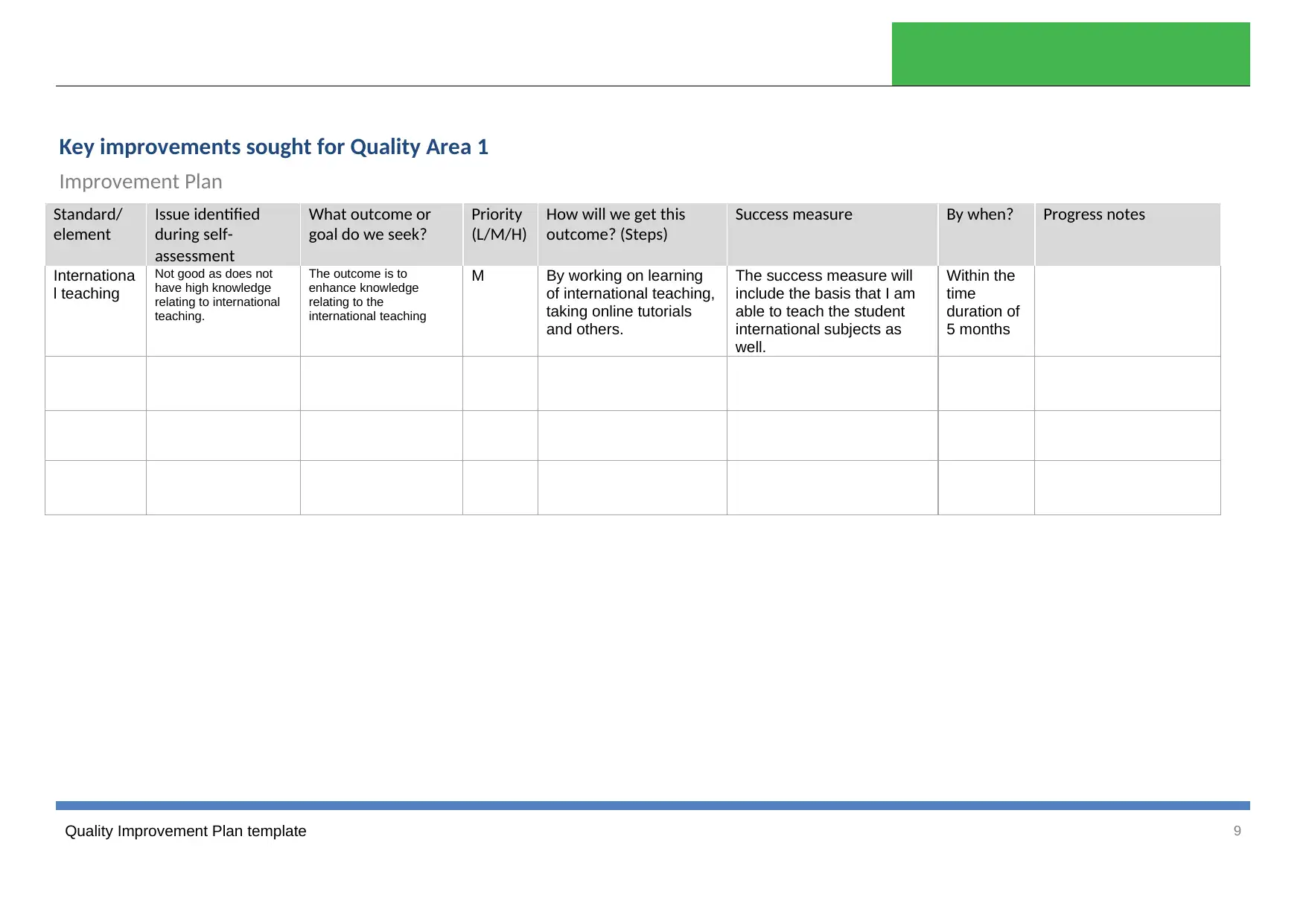
Key improvements sought for Quality Area 1
Improvement Plan
Quality Improvement Plan template 9
Standard/
element
Issue identified
during self-
assessment
What outcome or
goal do we seek?
Priority
(L/M/H)
How will we get this
outcome? (Steps)
Success measure By when? Progress notes
Internationa
l teaching
Not good as does not
have high knowledge
relating to international
teaching.
The outcome is to
enhance knowledge
relating to the
international teaching
M By working on learning
of international teaching,
taking online tutorials
and others.
The success measure will
include the basis that I am
able to teach the student
international subjects as
well.
Within the
time
duration of
5 months
Improvement Plan
Quality Improvement Plan template 9
Standard/
element
Issue identified
during self-
assessment
What outcome or
goal do we seek?
Priority
(L/M/H)
How will we get this
outcome? (Steps)
Success measure By when? Progress notes
Internationa
l teaching
Not good as does not
have high knowledge
relating to international
teaching.
The outcome is to
enhance knowledge
relating to the
international teaching
M By working on learning
of international teaching,
taking online tutorials
and others.
The success measure will
include the basis that I am
able to teach the student
international subjects as
well.
Within the
time
duration of
5 months
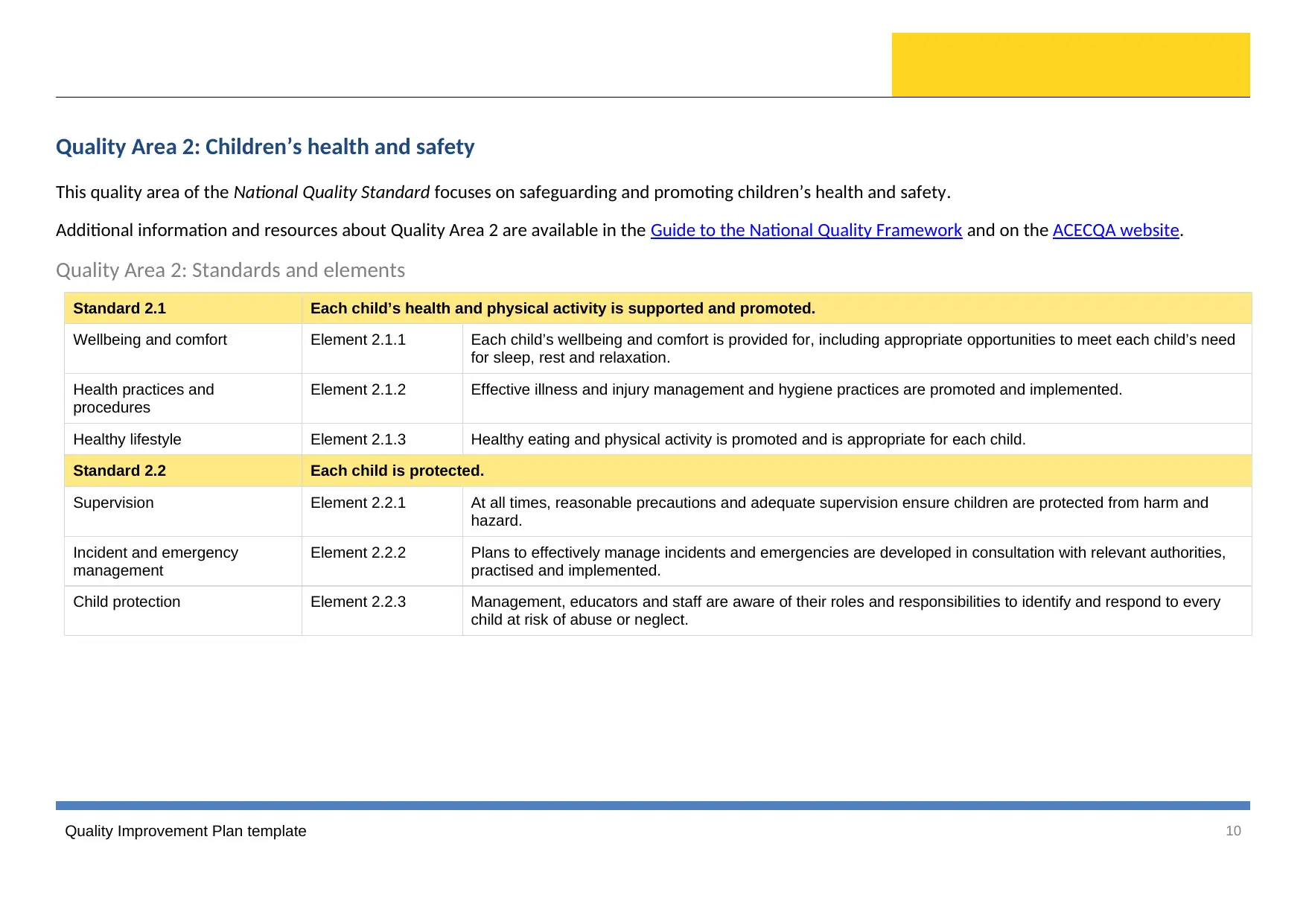
Quality Area 2: Children’s health and safety
This quality area of the National Quality Standard focuses on safeguarding and promoting children’s health and safety.
Additional information and resources about Quality Area 2 are available in the Guide to the National Quality Framework and on the ACECQA website.
Quality Area 2: Standards and elements
Standard 2.1 Each child’s health and physical activity is supported and promoted.
Wellbeing and comfort Element 2.1.1 Each child’s wellbeing and comfort is provided for, including appropriate opportunities to meet each child’s need
for sleep, rest and relaxation.
Health practices and
procedures
Element 2.1.2 Effective illness and injury management and hygiene practices are promoted and implemented.
Healthy lifestyle Element 2.1.3 Healthy eating and physical activity is promoted and is appropriate for each child.
Standard 2.2 Each child is protected.
Supervision Element 2.2.1 At all times, reasonable precautions and adequate supervision ensure children are protected from harm and
hazard.
Incident and emergency
management
Element 2.2.2 Plans to effectively manage incidents and emergencies are developed in consultation with relevant authorities,
practised and implemented.
Child protection Element 2.2.3 Management, educators and staff are aware of their roles and responsibilities to identify and respond to every
child at risk of abuse or neglect.
Quality Improvement Plan template 10
This quality area of the National Quality Standard focuses on safeguarding and promoting children’s health and safety.
Additional information and resources about Quality Area 2 are available in the Guide to the National Quality Framework and on the ACECQA website.
Quality Area 2: Standards and elements
Standard 2.1 Each child’s health and physical activity is supported and promoted.
Wellbeing and comfort Element 2.1.1 Each child’s wellbeing and comfort is provided for, including appropriate opportunities to meet each child’s need
for sleep, rest and relaxation.
Health practices and
procedures
Element 2.1.2 Effective illness and injury management and hygiene practices are promoted and implemented.
Healthy lifestyle Element 2.1.3 Healthy eating and physical activity is promoted and is appropriate for each child.
Standard 2.2 Each child is protected.
Supervision Element 2.2.1 At all times, reasonable precautions and adequate supervision ensure children are protected from harm and
hazard.
Incident and emergency
management
Element 2.2.2 Plans to effectively manage incidents and emergencies are developed in consultation with relevant authorities,
practised and implemented.
Child protection Element 2.2.3 Management, educators and staff are aware of their roles and responsibilities to identify and respond to every
child at risk of abuse or neglect.
Quality Improvement Plan template 10
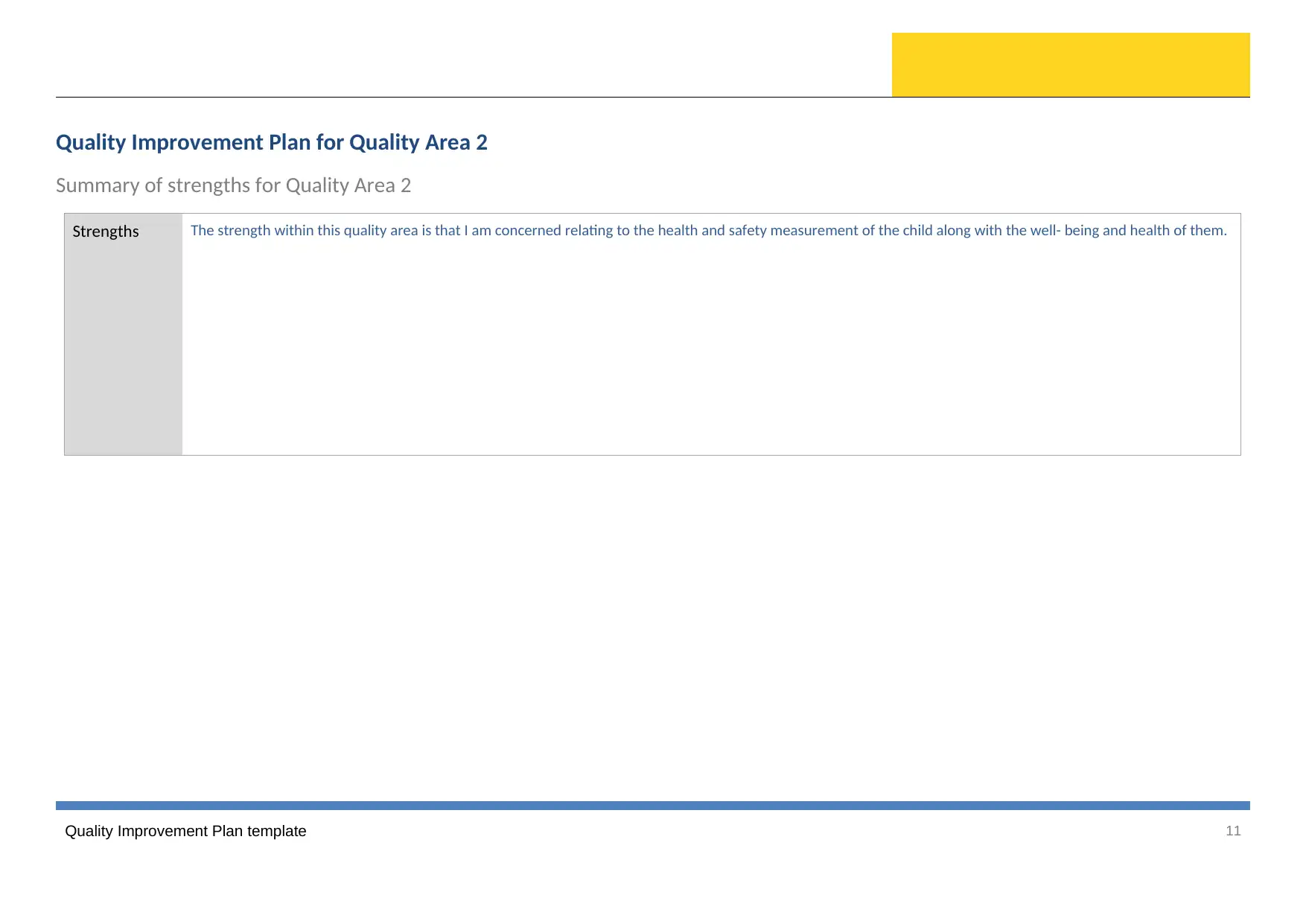
Quality Improvement Plan for Quality Area 2
Summary of strengths for Quality Area 2
Strengths The strength within this quality area is that I am concerned relating to the health and safety measurement of the child along with the well- being and health of them.
Quality Improvement Plan template 11
Summary of strengths for Quality Area 2
Strengths The strength within this quality area is that I am concerned relating to the health and safety measurement of the child along with the well- being and health of them.
Quality Improvement Plan template 11
Secure Best Marks with AI Grader
Need help grading? Try our AI Grader for instant feedback on your assignments.
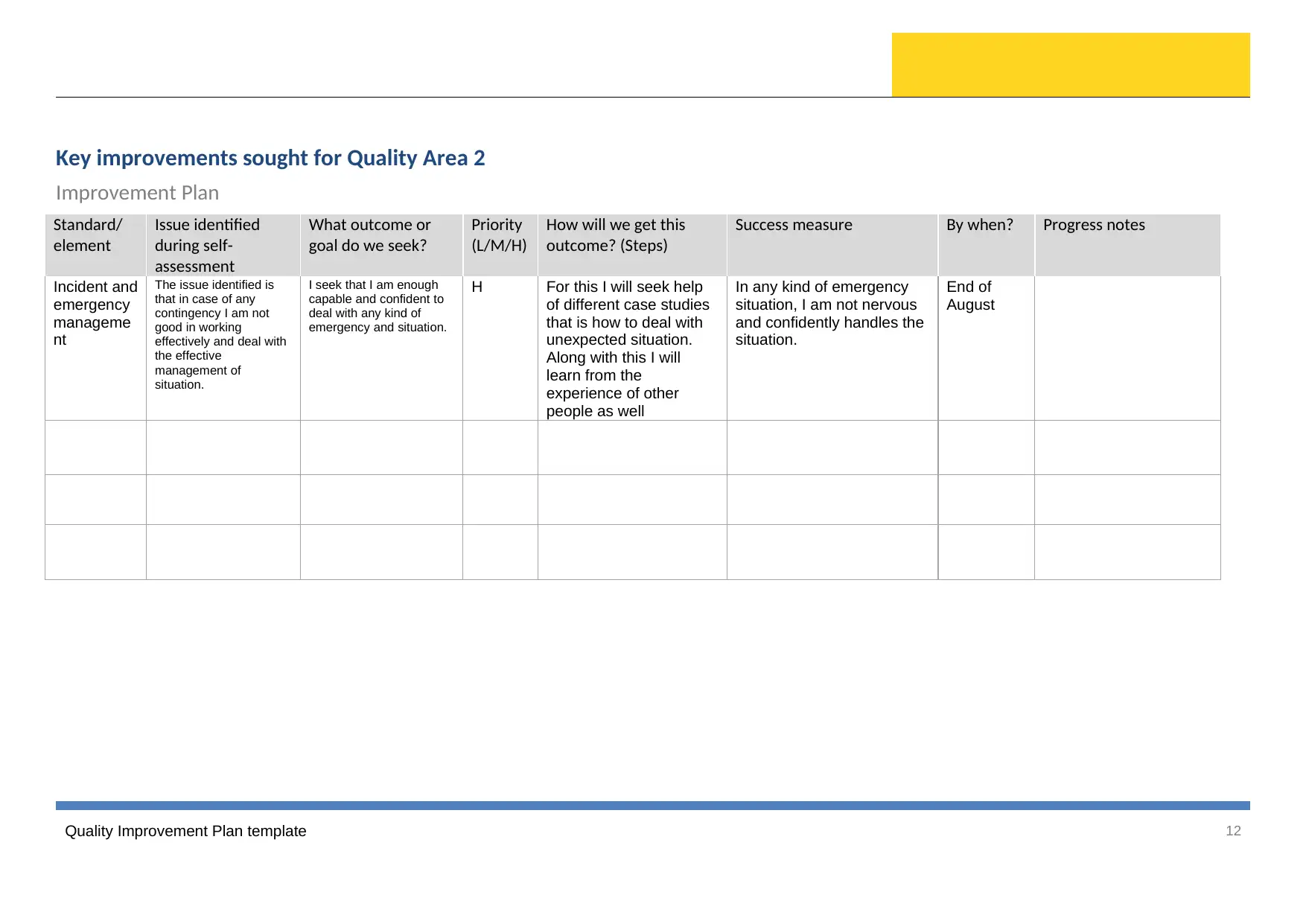
Key improvements sought for Quality Area 2
Improvement Plan
Quality Improvement Plan template 12
Standard/
element
Issue identified
during self-
assessment
What outcome or
goal do we seek?
Priority
(L/M/H)
How will we get this
outcome? (Steps)
Success measure By when? Progress notes
Incident and
emergency
manageme
nt
The issue identified is
that in case of any
contingency I am not
good in working
effectively and deal with
the effective
management of
situation.
I seek that I am enough
capable and confident to
deal with any kind of
emergency and situation.
H For this I will seek help
of different case studies
that is how to deal with
unexpected situation.
Along with this I will
learn from the
experience of other
people as well
In any kind of emergency
situation, I am not nervous
and confidently handles the
situation.
End of
August
Improvement Plan
Quality Improvement Plan template 12
Standard/
element
Issue identified
during self-
assessment
What outcome or
goal do we seek?
Priority
(L/M/H)
How will we get this
outcome? (Steps)
Success measure By when? Progress notes
Incident and
emergency
manageme
nt
The issue identified is
that in case of any
contingency I am not
good in working
effectively and deal with
the effective
management of
situation.
I seek that I am enough
capable and confident to
deal with any kind of
emergency and situation.
H For this I will seek help
of different case studies
that is how to deal with
unexpected situation.
Along with this I will
learn from the
experience of other
people as well
In any kind of emergency
situation, I am not nervous
and confidently handles the
situation.
End of
August
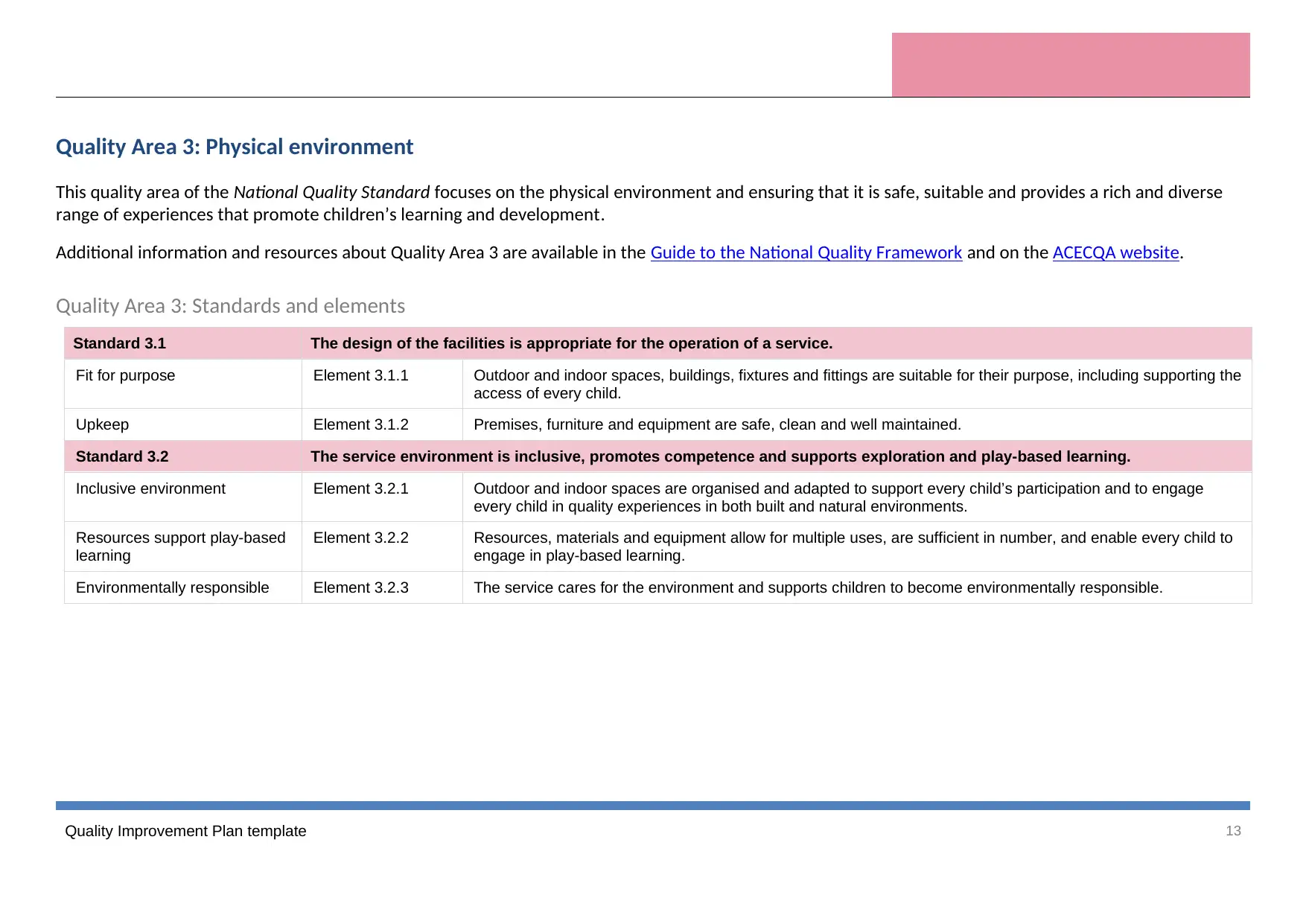
Quality Area 3: Physical environment
This quality area of the National Quality Standard focuses on the physical environment and ensuring that it is safe, suitable and provides a rich and diverse
range of experiences that promote children’s learning and development.
Additional information and resources about Quality Area 3 are available in the Guide to the National Quality Framework and on the ACECQA website.
Quality Area 3: Standards and elements
Standard 3.1 The design of the facilities is appropriate for the operation of a service.
Fit for purpose Element 3.1.1 Outdoor and indoor spaces, buildings, fixtures and fittings are suitable for their purpose, including supporting the
access of every child.
Upkeep Element 3.1.2 Premises, furniture and equipment are safe, clean and well maintained.
Standard 3.2 The service environment is inclusive, promotes competence and supports exploration and play-based learning.
Inclusive environment Element 3.2.1 Outdoor and indoor spaces are organised and adapted to support every child’s participation and to engage
every child in quality experiences in both built and natural environments.
Resources support play-based
learning
Element 3.2.2 Resources, materials and equipment allow for multiple uses, are sufficient in number, and enable every child to
engage in play-based learning.
Environmentally responsible Element 3.2.3 The service cares for the environment and supports children to become environmentally responsible.
Quality Improvement Plan template 13
This quality area of the National Quality Standard focuses on the physical environment and ensuring that it is safe, suitable and provides a rich and diverse
range of experiences that promote children’s learning and development.
Additional information and resources about Quality Area 3 are available in the Guide to the National Quality Framework and on the ACECQA website.
Quality Area 3: Standards and elements
Standard 3.1 The design of the facilities is appropriate for the operation of a service.
Fit for purpose Element 3.1.1 Outdoor and indoor spaces, buildings, fixtures and fittings are suitable for their purpose, including supporting the
access of every child.
Upkeep Element 3.1.2 Premises, furniture and equipment are safe, clean and well maintained.
Standard 3.2 The service environment is inclusive, promotes competence and supports exploration and play-based learning.
Inclusive environment Element 3.2.1 Outdoor and indoor spaces are organised and adapted to support every child’s participation and to engage
every child in quality experiences in both built and natural environments.
Resources support play-based
learning
Element 3.2.2 Resources, materials and equipment allow for multiple uses, are sufficient in number, and enable every child to
engage in play-based learning.
Environmentally responsible Element 3.2.3 The service cares for the environment and supports children to become environmentally responsible.
Quality Improvement Plan template 13
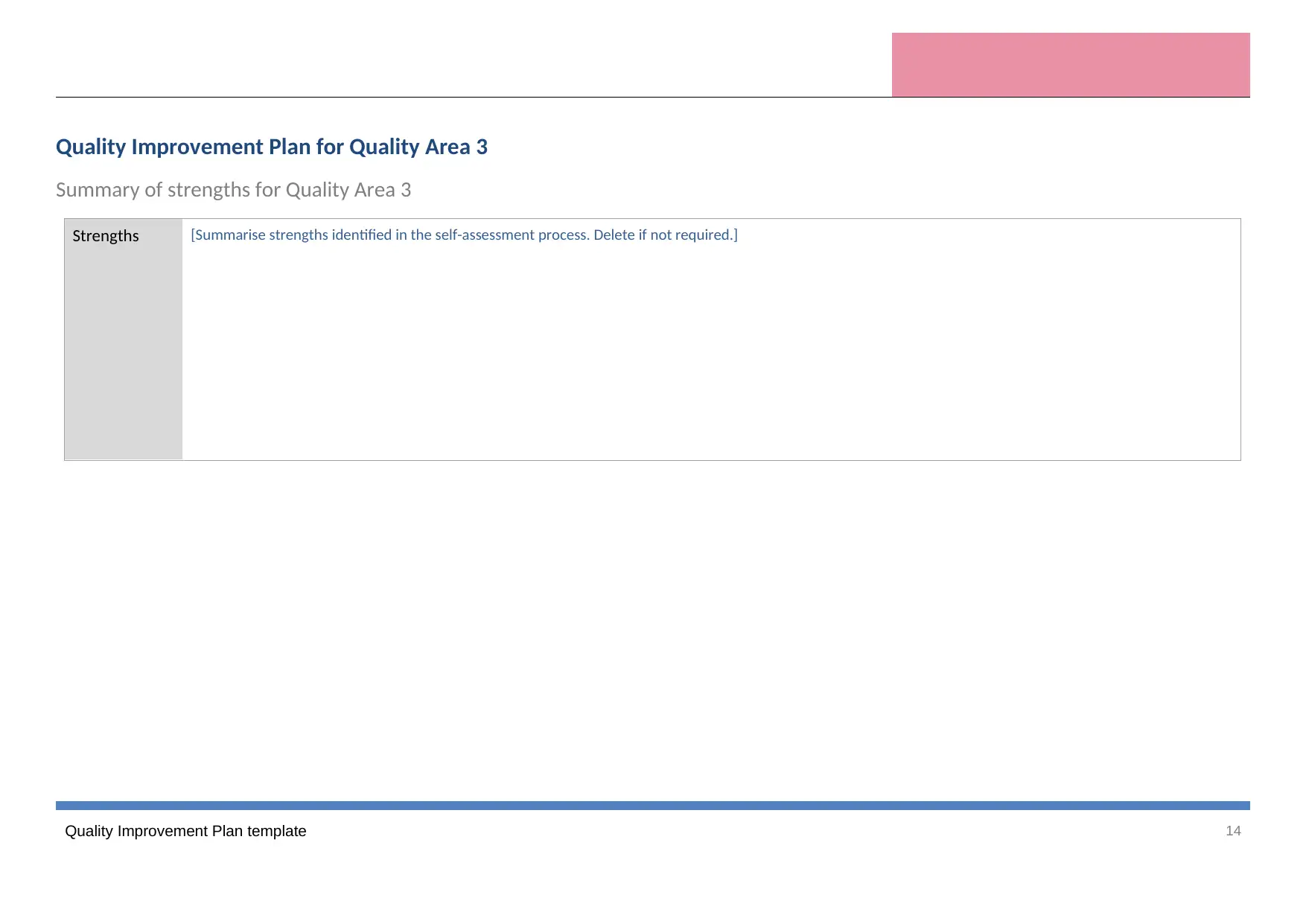
Quality Improvement Plan for Quality Area 3
Summary of strengths for Quality Area 3
Strengths [Summarise strengths identified in the self-assessment process. Delete if not required.]
Quality Improvement Plan template 14
Summary of strengths for Quality Area 3
Strengths [Summarise strengths identified in the self-assessment process. Delete if not required.]
Quality Improvement Plan template 14
Paraphrase This Document
Need a fresh take? Get an instant paraphrase of this document with our AI Paraphraser

Key improvements sought for Quality Area 3
Improvement Plan
Quality Improvement Plan template 15
Standard/
element
Issue identified
during self-
assessment
What outcome or
goal do we seek?
Priority
(L/M/H)
How will we get this
outcome? (Steps)
Success measure By when? Progress notes
Improvement Plan
Quality Improvement Plan template 15
Standard/
element
Issue identified
during self-
assessment
What outcome or
goal do we seek?
Priority
(L/M/H)
How will we get this
outcome? (Steps)
Success measure By when? Progress notes
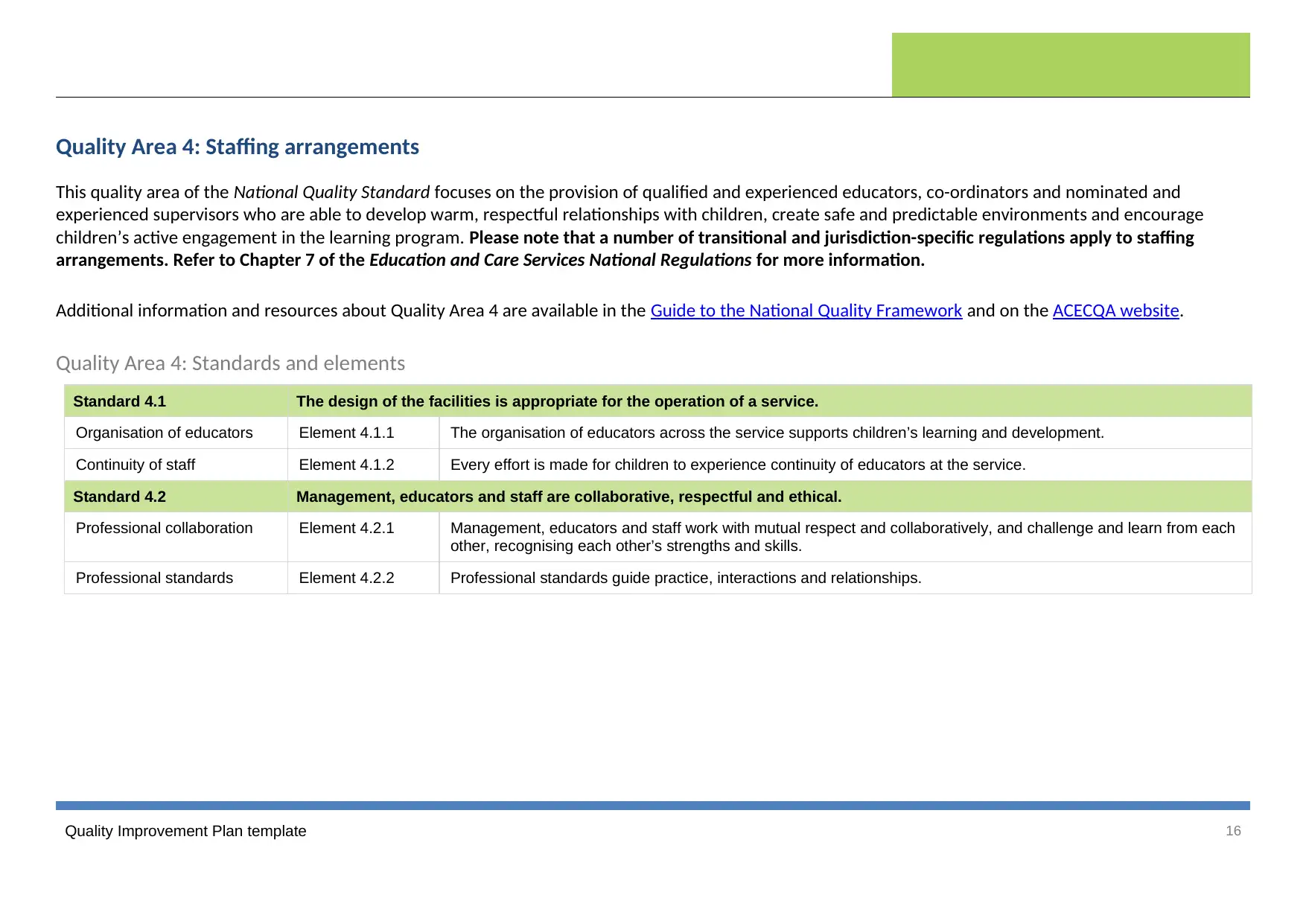
Quality Area 4: Staffing arrangements
This quality area of the National Quality Standard focuses on the provision of qualified and experienced educators, co-ordinators and nominated and
experienced supervisors who are able to develop warm, respectful relationships with children, create safe and predictable environments and encourage
children’s active engagement in the learning program. Please note that a number of transitional and jurisdiction-specific regulations apply to staffing
arrangements. Refer to Chapter 7 of the Education and Care Services National Regulations for more information.
Additional information and resources about Quality Area 4 are available in the Guide to the National Quality Framework and on the ACECQA website.
Quality Area 4: Standards and elements
Standard 4.1 The design of the facilities is appropriate for the operation of a service.
Organisation of educators Element 4.1.1 The organisation of educators across the service supports children’s learning and development.
Continuity of staff Element 4.1.2 Every effort is made for children to experience continuity of educators at the service.
Standard 4.2 Management, educators and staff are collaborative, respectful and ethical.
Professional collaboration Element 4.2.1 Management, educators and staff work with mutual respect and collaboratively, and challenge and learn from each
other, recognising each other’s strengths and skills.
Professional standards Element 4.2.2 Professional standards guide practice, interactions and relationships.
Quality Improvement Plan template 16
This quality area of the National Quality Standard focuses on the provision of qualified and experienced educators, co-ordinators and nominated and
experienced supervisors who are able to develop warm, respectful relationships with children, create safe and predictable environments and encourage
children’s active engagement in the learning program. Please note that a number of transitional and jurisdiction-specific regulations apply to staffing
arrangements. Refer to Chapter 7 of the Education and Care Services National Regulations for more information.
Additional information and resources about Quality Area 4 are available in the Guide to the National Quality Framework and on the ACECQA website.
Quality Area 4: Standards and elements
Standard 4.1 The design of the facilities is appropriate for the operation of a service.
Organisation of educators Element 4.1.1 The organisation of educators across the service supports children’s learning and development.
Continuity of staff Element 4.1.2 Every effort is made for children to experience continuity of educators at the service.
Standard 4.2 Management, educators and staff are collaborative, respectful and ethical.
Professional collaboration Element 4.2.1 Management, educators and staff work with mutual respect and collaboratively, and challenge and learn from each
other, recognising each other’s strengths and skills.
Professional standards Element 4.2.2 Professional standards guide practice, interactions and relationships.
Quality Improvement Plan template 16
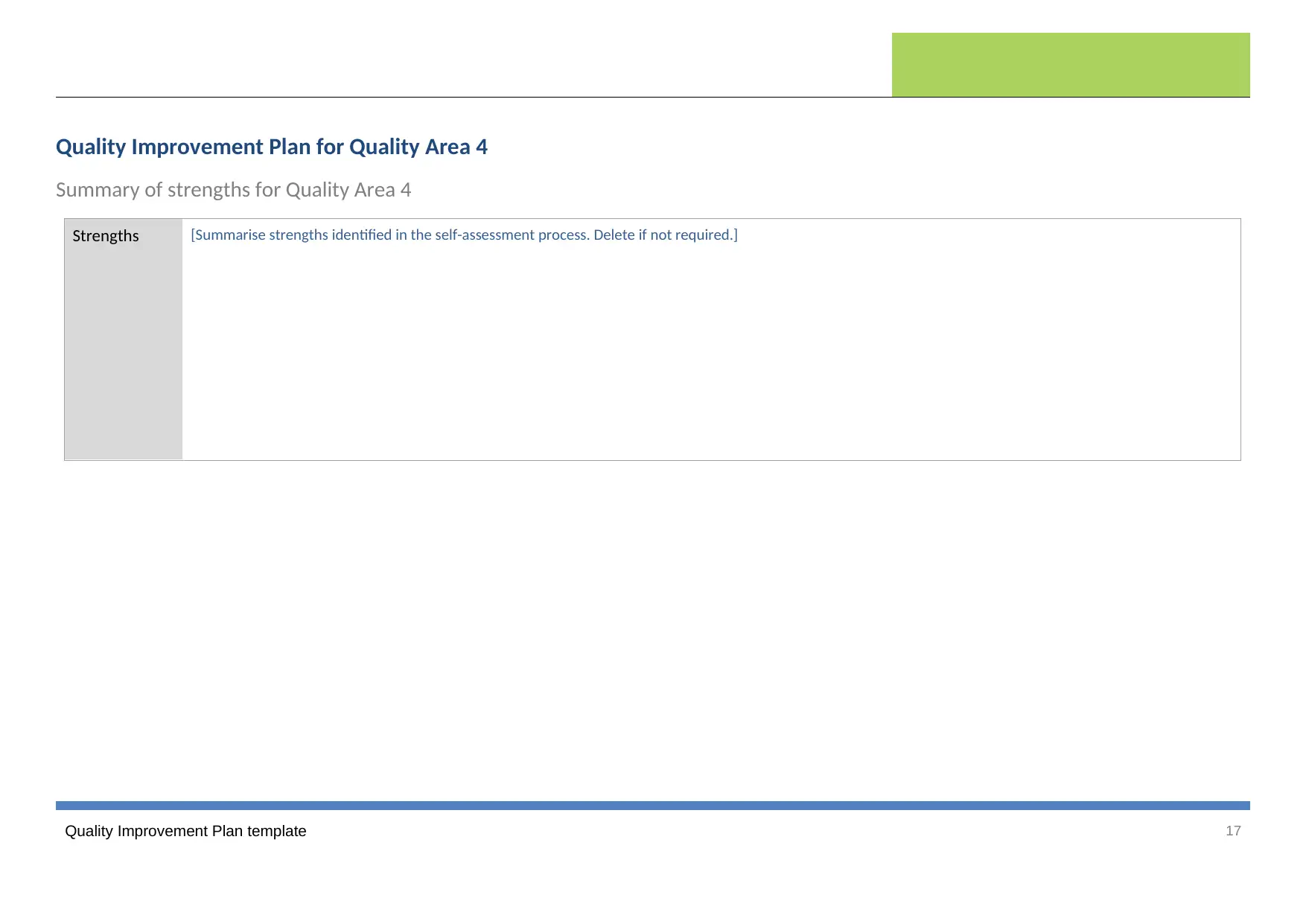
Quality Improvement Plan for Quality Area 4
Summary of strengths for Quality Area 4
Strengths [Summarise strengths identified in the self-assessment process. Delete if not required.]
Quality Improvement Plan template 17
Summary of strengths for Quality Area 4
Strengths [Summarise strengths identified in the self-assessment process. Delete if not required.]
Quality Improvement Plan template 17
Secure Best Marks with AI Grader
Need help grading? Try our AI Grader for instant feedback on your assignments.
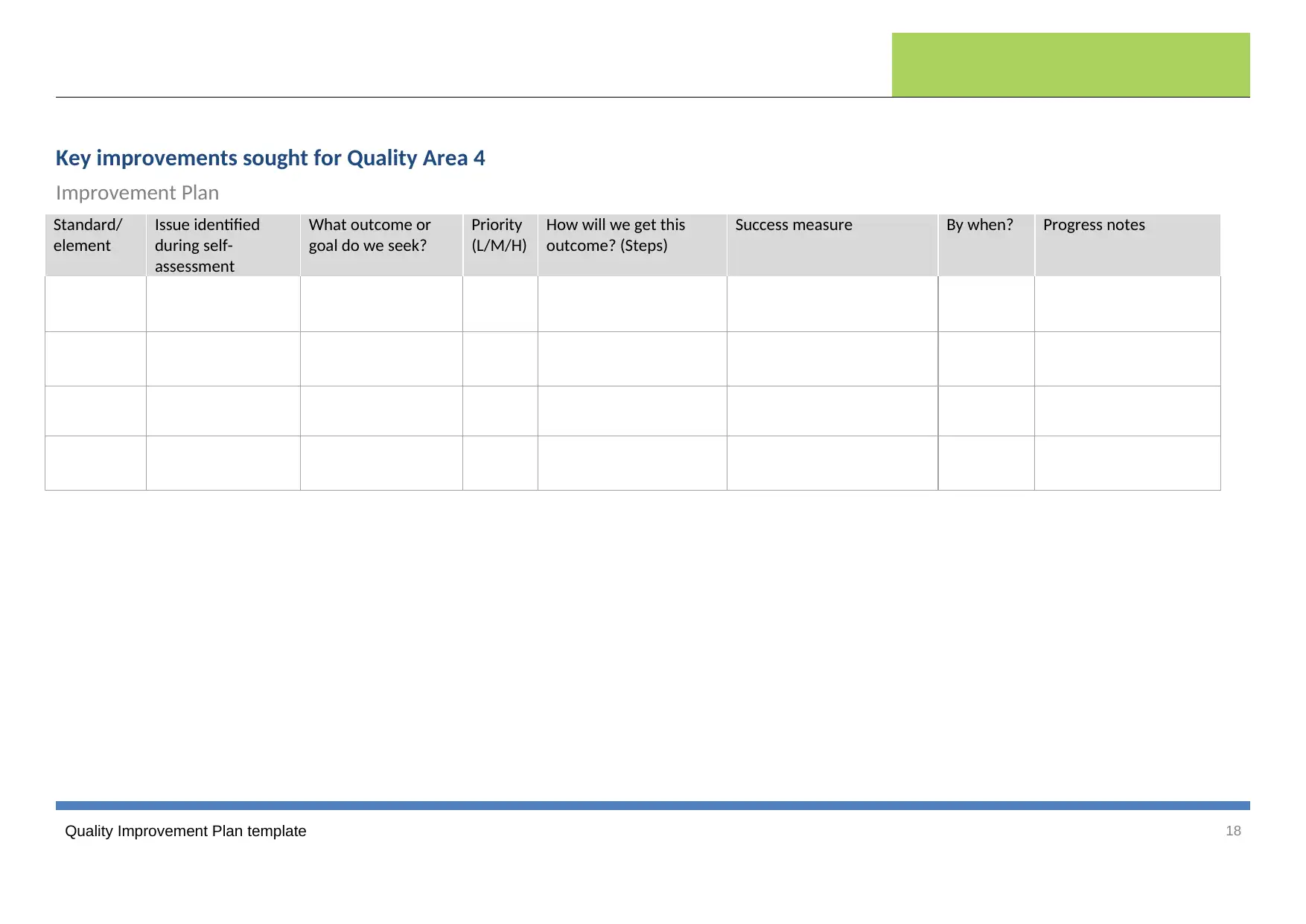
Key improvements sought for Quality Area 4
Improvement Plan
Quality Improvement Plan template 18
Standard/
element
Issue identified
during self-
assessment
What outcome or
goal do we seek?
Priority
(L/M/H)
How will we get this
outcome? (Steps)
Success measure By when? Progress notes
Improvement Plan
Quality Improvement Plan template 18
Standard/
element
Issue identified
during self-
assessment
What outcome or
goal do we seek?
Priority
(L/M/H)
How will we get this
outcome? (Steps)
Success measure By when? Progress notes

Quality Area 5: Relationships with children
This quality area of the National Quality Standard focuses on relationships with children being responsive, respectful and promoting children’s sense of
security and belonging. Relationships of this kind free children to explore the environment and engage in play and learning.
Additional information and resources about Quality Area 5 are available in the Guide to the National Quality Framework and on the ACECQA website.
Quality Area 5: Standards and elements
Standard 5.1 Respectful and equitable relationships are maintained with each child.
Positive educator to child
interactions
Element 5.1.1 Responsive and meaningful interactions build trusting relationships which engage and support each child to feel
secure, confident and included
Dignity and rights of the child Element 5.1.2 The dignity and the rights of every child are maintained.
Standard 5.2 Each child is supported to build and maintain sensitive and responsive relationships.
Collaborative learning Element 5.2.1 Children are supported to collaborate, learn from and help each other.
Self-regulation Element 5.2.2 Each child is supported to regulate their own behaviour, respond appropriately to the behaviour of others and
communicate effectively to resolve conflicts.
Quality Improvement Plan template 19
This quality area of the National Quality Standard focuses on relationships with children being responsive, respectful and promoting children’s sense of
security and belonging. Relationships of this kind free children to explore the environment and engage in play and learning.
Additional information and resources about Quality Area 5 are available in the Guide to the National Quality Framework and on the ACECQA website.
Quality Area 5: Standards and elements
Standard 5.1 Respectful and equitable relationships are maintained with each child.
Positive educator to child
interactions
Element 5.1.1 Responsive and meaningful interactions build trusting relationships which engage and support each child to feel
secure, confident and included
Dignity and rights of the child Element 5.1.2 The dignity and the rights of every child are maintained.
Standard 5.2 Each child is supported to build and maintain sensitive and responsive relationships.
Collaborative learning Element 5.2.1 Children are supported to collaborate, learn from and help each other.
Self-regulation Element 5.2.2 Each child is supported to regulate their own behaviour, respond appropriately to the behaviour of others and
communicate effectively to resolve conflicts.
Quality Improvement Plan template 19
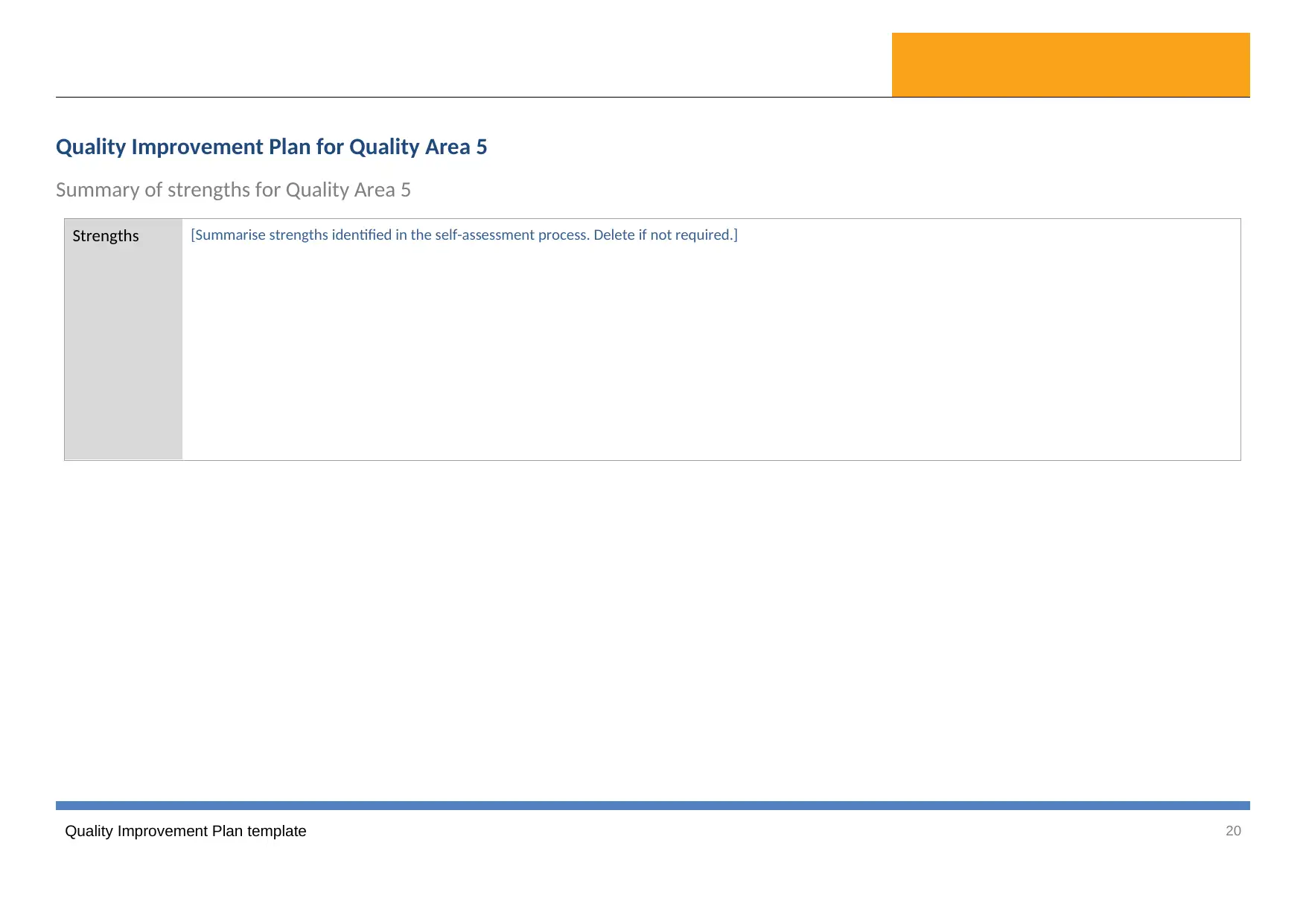
Quality Improvement Plan for Quality Area 5
Summary of strengths for Quality Area 5
Strengths [Summarise strengths identified in the self-assessment process. Delete if not required.]
Quality Improvement Plan template 20
Summary of strengths for Quality Area 5
Strengths [Summarise strengths identified in the self-assessment process. Delete if not required.]
Quality Improvement Plan template 20
Paraphrase This Document
Need a fresh take? Get an instant paraphrase of this document with our AI Paraphraser

Key improvements sought for Quality Area 5
Improvement Plan
Quality Improvement Plan template 21
Standard/
element
Issue identified
during self-
assessment
What outcome or
goal do we seek?
Priority
(L/M/H)
How will we get this
outcome? (Steps)
Success measure By when? Progress notes
Improvement Plan
Quality Improvement Plan template 21
Standard/
element
Issue identified
during self-
assessment
What outcome or
goal do we seek?
Priority
(L/M/H)
How will we get this
outcome? (Steps)
Success measure By when? Progress notes
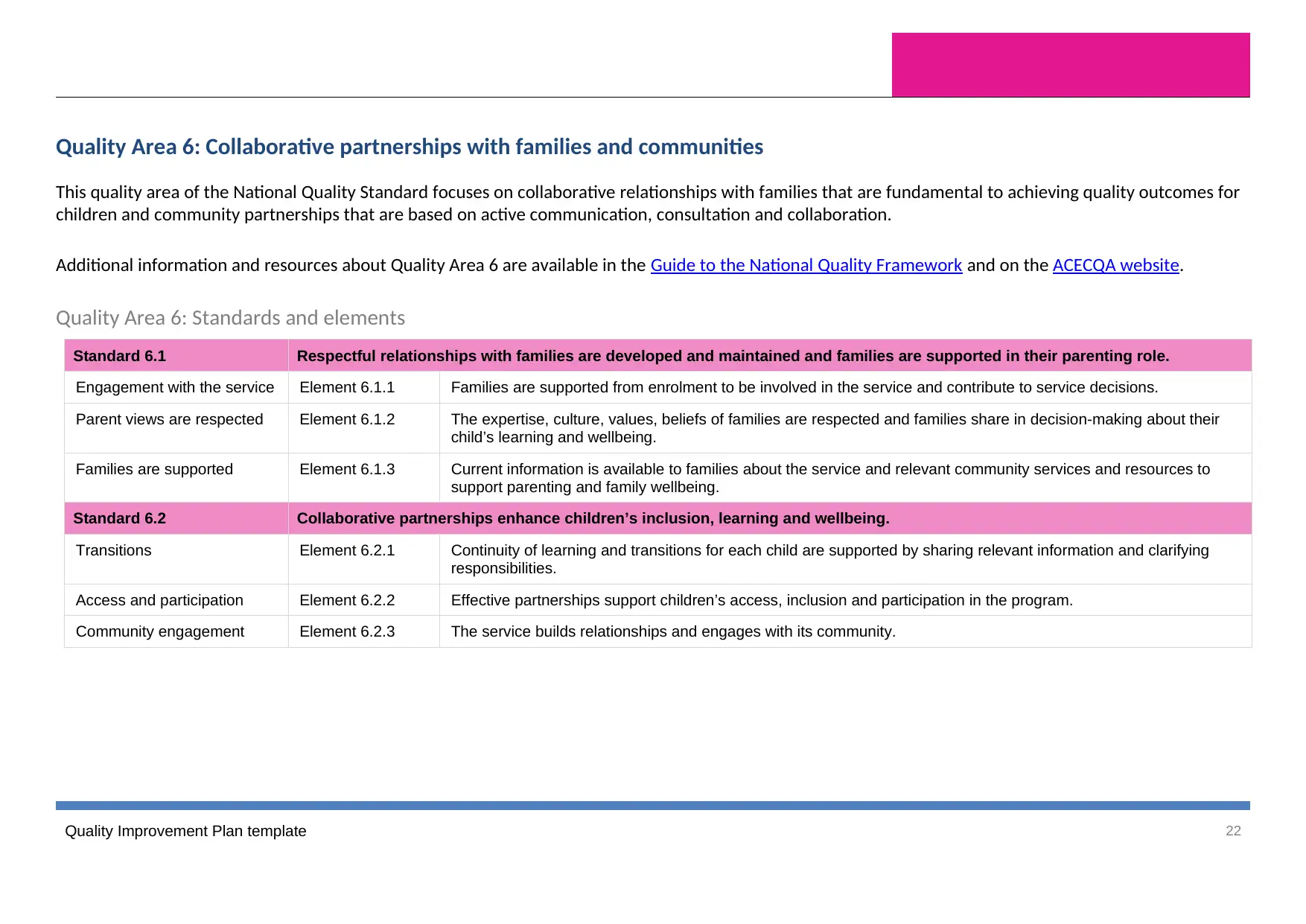
Quality Area 6: Collaborative partnerships with families and communities
This quality area of the National Quality Standard focuses on collaborative relationships with families that are fundamental to achieving quality outcomes for
children and community partnerships that are based on active communication, consultation and collaboration.
Additional information and resources about Quality Area 6 are available in the Guide to the National Quality Framework and on the ACECQA website.
Quality Area 6: Standards and elements
Standard 6.1 Respectful relationships with families are developed and maintained and families are supported in their parenting role.
Engagement with the service Element 6.1.1 Families are supported from enrolment to be involved in the service and contribute to service decisions.
Parent views are respected Element 6.1.2 The expertise, culture, values, beliefs of families are respected and families share in decision-making about their
child’s learning and wellbeing.
Families are supported Element 6.1.3 Current information is available to families about the service and relevant community services and resources to
support parenting and family wellbeing.
Standard 6.2 Collaborative partnerships enhance children’s inclusion, learning and wellbeing.
Transitions Element 6.2.1 Continuity of learning and transitions for each child are supported by sharing relevant information and clarifying
responsibilities.
Access and participation Element 6.2.2 Effective partnerships support children’s access, inclusion and participation in the program.
Community engagement Element 6.2.3 The service builds relationships and engages with its community.
Quality Improvement Plan template 22
This quality area of the National Quality Standard focuses on collaborative relationships with families that are fundamental to achieving quality outcomes for
children and community partnerships that are based on active communication, consultation and collaboration.
Additional information and resources about Quality Area 6 are available in the Guide to the National Quality Framework and on the ACECQA website.
Quality Area 6: Standards and elements
Standard 6.1 Respectful relationships with families are developed and maintained and families are supported in their parenting role.
Engagement with the service Element 6.1.1 Families are supported from enrolment to be involved in the service and contribute to service decisions.
Parent views are respected Element 6.1.2 The expertise, culture, values, beliefs of families are respected and families share in decision-making about their
child’s learning and wellbeing.
Families are supported Element 6.1.3 Current information is available to families about the service and relevant community services and resources to
support parenting and family wellbeing.
Standard 6.2 Collaborative partnerships enhance children’s inclusion, learning and wellbeing.
Transitions Element 6.2.1 Continuity of learning and transitions for each child are supported by sharing relevant information and clarifying
responsibilities.
Access and participation Element 6.2.2 Effective partnerships support children’s access, inclusion and participation in the program.
Community engagement Element 6.2.3 The service builds relationships and engages with its community.
Quality Improvement Plan template 22
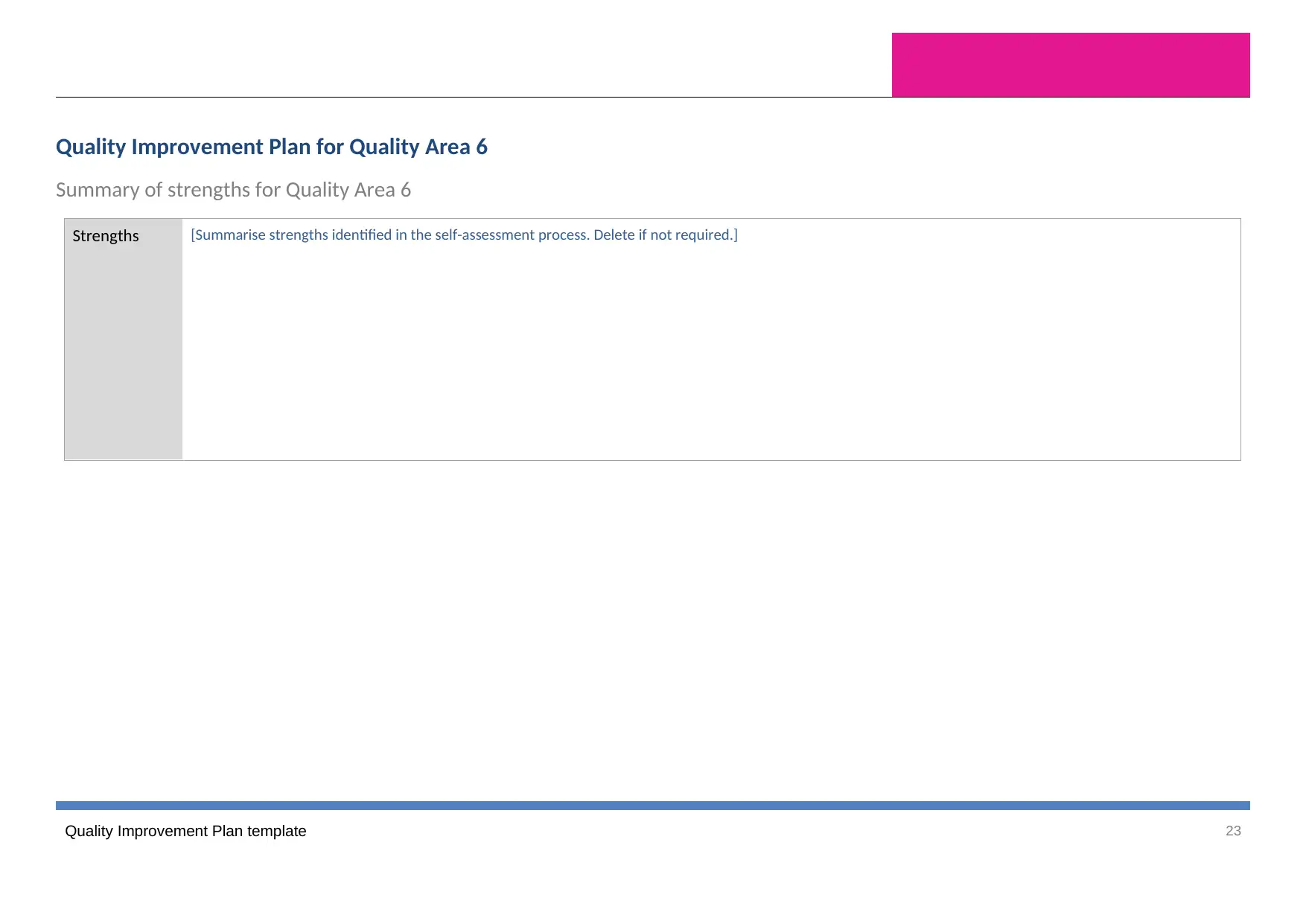
Quality Improvement Plan for Quality Area 6
Summary of strengths for Quality Area 6
Strengths [Summarise strengths identified in the self-assessment process. Delete if not required.]
Quality Improvement Plan template 23
Summary of strengths for Quality Area 6
Strengths [Summarise strengths identified in the self-assessment process. Delete if not required.]
Quality Improvement Plan template 23
Secure Best Marks with AI Grader
Need help grading? Try our AI Grader for instant feedback on your assignments.
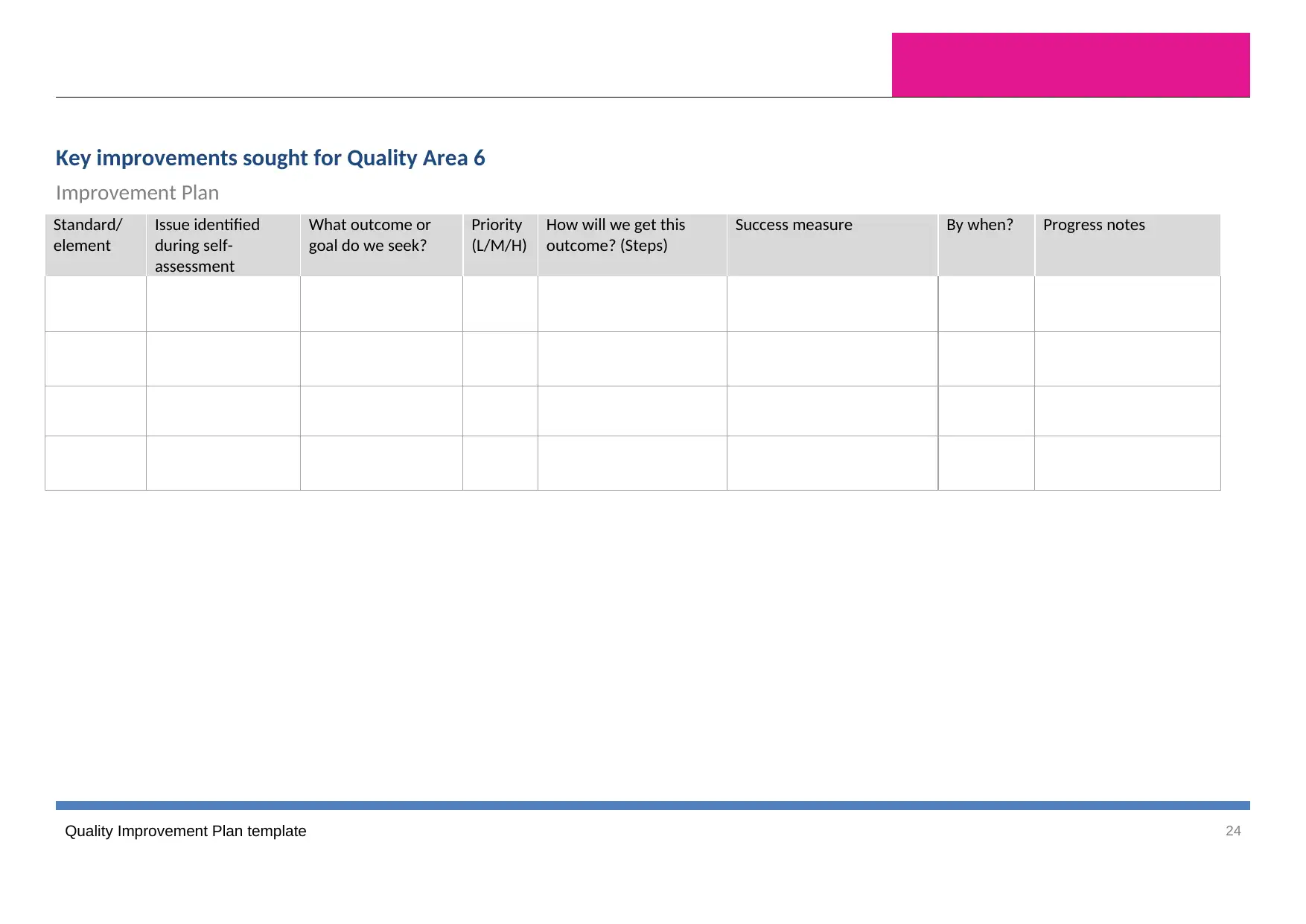
Key improvements sought for Quality Area 6
Improvement Plan
Quality Improvement Plan template 24
Standard/
element
Issue identified
during self-
assessment
What outcome or
goal do we seek?
Priority
(L/M/H)
How will we get this
outcome? (Steps)
Success measure By when? Progress notes
Improvement Plan
Quality Improvement Plan template 24
Standard/
element
Issue identified
during self-
assessment
What outcome or
goal do we seek?
Priority
(L/M/H)
How will we get this
outcome? (Steps)
Success measure By when? Progress notes
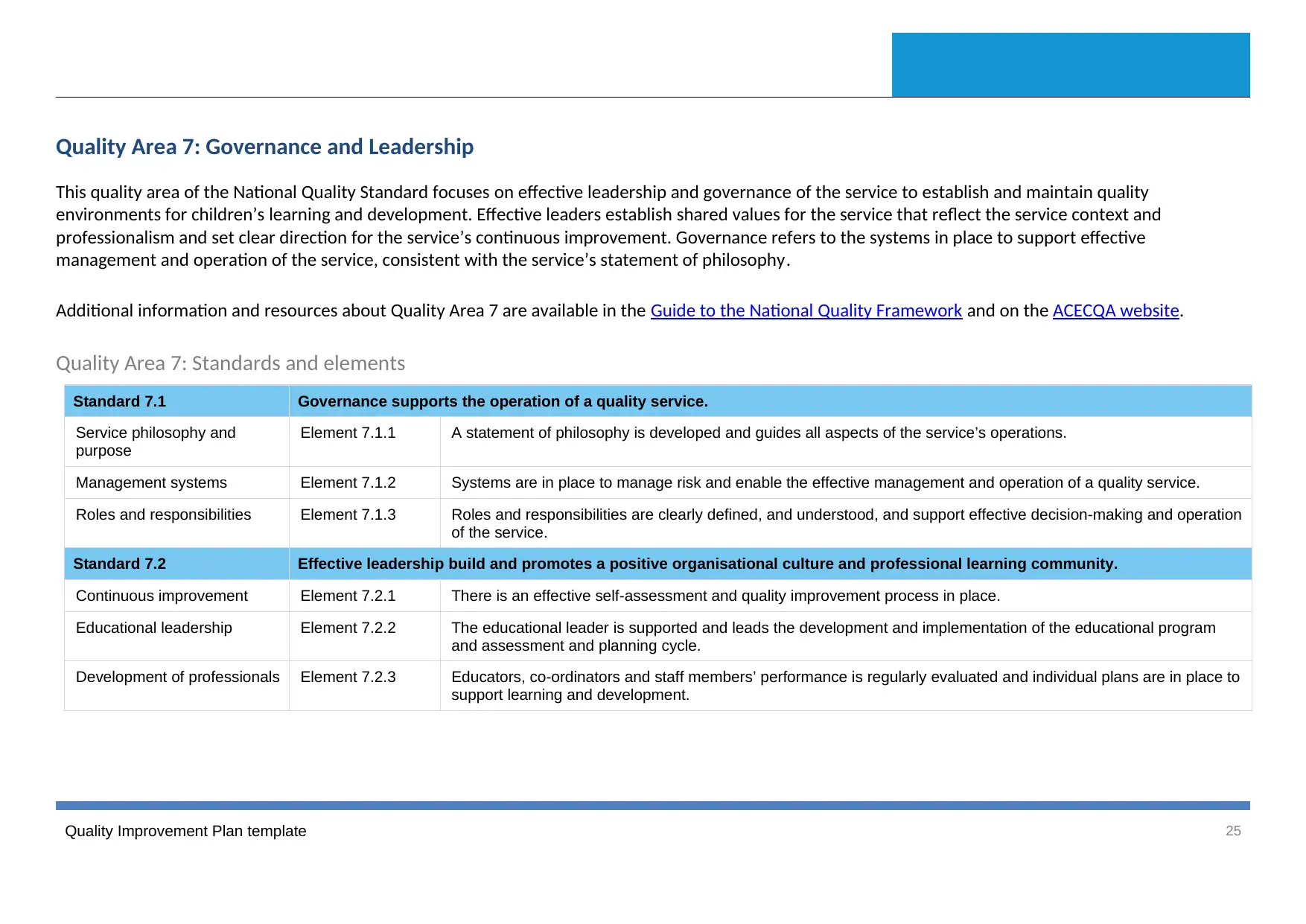
Quality Area 7: Governance and Leadership
This quality area of the National Quality Standard focuses on effective leadership and governance of the service to establish and maintain quality
environments for children’s learning and development. Effective leaders establish shared values for the service that reflect the service context and
professionalism and set clear direction for the service’s continuous improvement. Governance refers to the systems in place to support effective
management and operation of the service, consistent with the service’s statement of philosophy.
Additional information and resources about Quality Area 7 are available in the Guide to the National Quality Framework and on the ACECQA website.
Quality Area 7: Standards and elements
Standard 7.1 Governance supports the operation of a quality service.
Service philosophy and
purpose
Element 7.1.1 A statement of philosophy is developed and guides all aspects of the service’s operations.
Management systems Element 7.1.2 Systems are in place to manage risk and enable the effective management and operation of a quality service.
Roles and responsibilities Element 7.1.3 Roles and responsibilities are clearly defined, and understood, and support effective decision-making and operation
of the service.
Standard 7.2 Effective leadership build and promotes a positive organisational culture and professional learning community.
Continuous improvement Element 7.2.1 There is an effective self-assessment and quality improvement process in place.
Educational leadership Element 7.2.2 The educational leader is supported and leads the development and implementation of the educational program
and assessment and planning cycle.
Development of professionals Element 7.2.3 Educators, co-ordinators and staff members’ performance is regularly evaluated and individual plans are in place to
support learning and development.
Quality Improvement Plan template 25
This quality area of the National Quality Standard focuses on effective leadership and governance of the service to establish and maintain quality
environments for children’s learning and development. Effective leaders establish shared values for the service that reflect the service context and
professionalism and set clear direction for the service’s continuous improvement. Governance refers to the systems in place to support effective
management and operation of the service, consistent with the service’s statement of philosophy.
Additional information and resources about Quality Area 7 are available in the Guide to the National Quality Framework and on the ACECQA website.
Quality Area 7: Standards and elements
Standard 7.1 Governance supports the operation of a quality service.
Service philosophy and
purpose
Element 7.1.1 A statement of philosophy is developed and guides all aspects of the service’s operations.
Management systems Element 7.1.2 Systems are in place to manage risk and enable the effective management and operation of a quality service.
Roles and responsibilities Element 7.1.3 Roles and responsibilities are clearly defined, and understood, and support effective decision-making and operation
of the service.
Standard 7.2 Effective leadership build and promotes a positive organisational culture and professional learning community.
Continuous improvement Element 7.2.1 There is an effective self-assessment and quality improvement process in place.
Educational leadership Element 7.2.2 The educational leader is supported and leads the development and implementation of the educational program
and assessment and planning cycle.
Development of professionals Element 7.2.3 Educators, co-ordinators and staff members’ performance is regularly evaluated and individual plans are in place to
support learning and development.
Quality Improvement Plan template 25
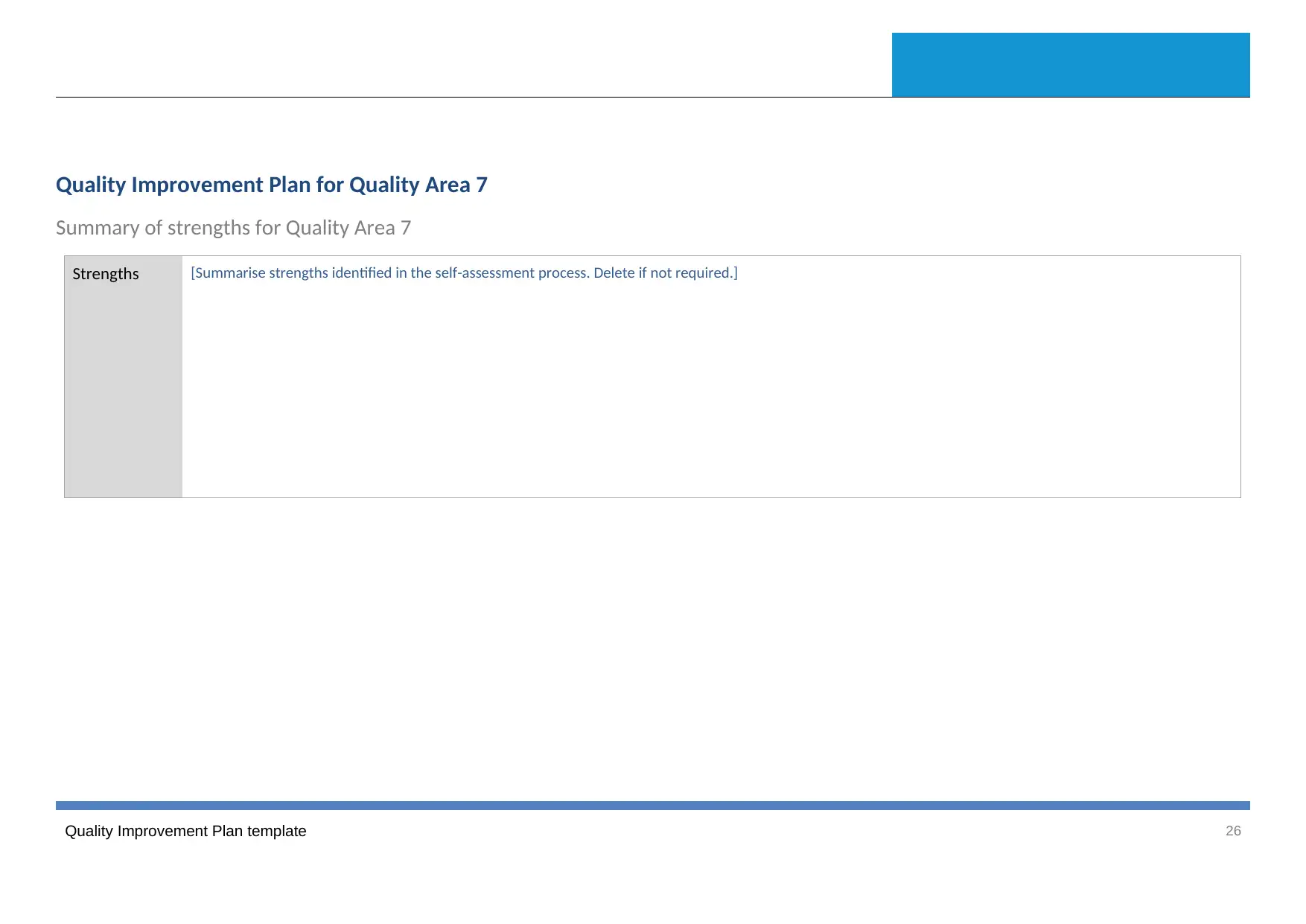
Quality Improvement Plan for Quality Area 7
Summary of strengths for Quality Area 7
Strengths [Summarise strengths identified in the self-assessment process. Delete if not required.]
Quality Improvement Plan template 26
Summary of strengths for Quality Area 7
Strengths [Summarise strengths identified in the self-assessment process. Delete if not required.]
Quality Improvement Plan template 26
Paraphrase This Document
Need a fresh take? Get an instant paraphrase of this document with our AI Paraphraser

Key improvements sought for Quality Area 7
Improvement Plan
Standard/
element
Issue identified
during self-
assessment
What outcome or
goal do we seek?
Priority
(L/M/H)
How will we get this
outcome? (Steps)
Success measure By when? Progress notes
Quality Improvement Plan template 27
Improvement Plan
Standard/
element
Issue identified
during self-
assessment
What outcome or
goal do we seek?
Priority
(L/M/H)
How will we get this
outcome? (Steps)
Success measure By when? Progress notes
Quality Improvement Plan template 27

Notes
This tool has been adapted for use. The original document, in full, can be located at: https://www.acecqa.gov.au/assessment/quality-
improvement-plans
Quality Improvement Plan template 28
This tool has been adapted for use. The original document, in full, can be located at: https://www.acecqa.gov.au/assessment/quality-
improvement-plans
Quality Improvement Plan template 28
1 out of 27
Related Documents
Your All-in-One AI-Powered Toolkit for Academic Success.
+13062052269
info@desklib.com
Available 24*7 on WhatsApp / Email
![[object Object]](/_next/static/media/star-bottom.7253800d.svg)
Unlock your academic potential
© 2024 | Zucol Services PVT LTD | All rights reserved.


![[FULL ACCESS] Policies and Procedures for Family Day Care Service](/_next/image/?url=https%3A%2F%2Fdesklib.com%2Fmedia%2Fimages%2Fax%2F86b0877f2773431eb475d48c90cbcb3c.jpg&w=256&q=75)


